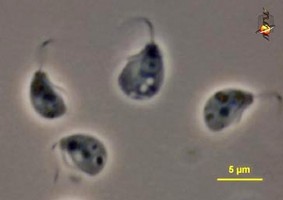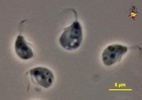Malawimonads
Malawimonas
Alastair Simpson- 'Malawimonas californiana'
- Malawimonas jakobiformis
Introduction
Characteristics
Malawimonads are free-swimming heterotrophic flagellates. They are small, typically about 5 μm long (Malawimonas jakobiformis is 4-8.5 μm - O'Kelly and Nerad, 1999). Cells are bean-shaped, with two flagella and a ventral groove (O’Kelly and Nerad, 1999; Simpson unpublished). Like other small free-living excavates, malawimonads use the groove to collect and phagocytose small food particles (prokaryotes) that are transported on a current generated by the posterior flagellum. Malawimonads have been cultured from freshwater sediments and soil (O’Kelly and Nerad 1999; Ekelund 2002, under the name Carpediemonas sp. – Simpson, unpublished). Malawimonas jakobiformis forms cysts (O’Kelly and Nerad, 1999).
Malawimonads closely resemble other small excavate free-living excavates when viewed under the light microscope, in particular deep-branching members of Fornicata, namely Carpediemonas and Dynectes (from which they are almost indistinguishable), and non-loricate jakobids such as Jakoba and Andalucia. Ultrastructural examination indicates that malawimonads differ from these other small excavates by having discoidal mitochondrial cristae (O’Kelly, 1993; O’Kelly and Nerad, 1999; Simpson, unpublished). By contrast, jakobids have tubular or flat cristae (O’Kelly, 1993; Lara et al., 2006) while the mitochondrion-like organelles of Carpediemonas and Dysnectes lack cristae (Simpson and Patterson, 1999; Yubuki et al. 2007). Malawimonas jakobiformis has a single vane on its posterior flagellum that is located on the ventral side of the axoneme, rather than the dorsal side of the axoneme, as is characteristic for jakobids (O’Kelly and Nerad, 1999). Malawimonads lack the other synapomorphies of jakobids, and also lack the diagnostic arched fibre synapomorphy for Fornicata (O’Kelly and Nerad, 1999; Simpson, unpublished – see Simpson and Patterson, 1999, 2001; Yubuki et al. 2007; Simpson, 2003).
The mitochondrial genomes of Malawimonas jakobiformis and ‘Malawimonas californiana’ have been sequenced (Lang et al., 1999; Gray et al., 2004). The Malawimonas mitochondrial genomes are relatively gene-rich, with ~70 total unique genes and ORFs (Lang et al., 1999). Three ORFs are unique to Malawimonas, while three of the genes for ribosomal proteins are otherwise only known from jakobid mitochondrial genomes (Gray et al., 2004). Other than these three genes, Malawimonas lacks most of the unusual ‘bacterial-like’ features of jakobid mitochondrial genomes, including genes for eubacterial-type RNA polymerase subunits (Gray et al., 2004).
References
Ekelund F. (2002) Tolerance of soil flagellates to increased NaCl levels. J. Eukaryot. Microbiol. 49: 324-328.
Gray, M. W., Lang, B. F. & Burger, G. (2004) Mitochondria of protists. Annu. Rev. Genet. 38: 477-525.
Lang, B. F., Gray, M.W., & Burger, G. (1999) Mitochondrial genome evolution and the origin of eukaryotes. Annu. Rev. Genet. 33: 351-397.
Lara, E., Chatzinotas, A., Simpson, A.G.B. (2006) Andalucia (gen. nov,): a new taxon for the deepest branch within jakobids (Jakobida; Excavata), based on morphological and molecular study of a new flagellate from soil. J. Eukaryot. Microbiol. 53: 112-120.
O’Kelly, C. J. (1993) The jakobid flagellates: structural features of Jakoba, Reclinomonas and Histiona and implications for the early diversification of eukaryotes. J. Eukaryot. Microbiol. 40: 627--636.
O’Kelly, C.J. & Nerad, T.A. (1999) Malawimonas jakobiformis n. gen., n. sp. (Malawimonadidae n. fam.): A jakoba-like heterotrophic nanoflagellate with discoidal mitochondrial cristae. J. Eukaryot. Microbiol. 46: 522-531.
Simpson, A.G.B. (2003) Cytoskeletal organisation phylogenetic affinities and systematics in the contentious taxon Excavata (Eukaryota). Int. J. Syst. Evol. Microbiol. 53: 1759-1777.
Simpson, A.G.B. & Patterson, D.J. (1999) The ultrastructure of Carpediemonas membranifera (Eukaryota) with reference to the “excavate hypothesis”. Europ. J. Protistol. 35: 353-370.
Simpson, A.G.B. & Patterson, D.J. (2001) On core jakobids and excavate taxa: the ultrastructure of Jakoba incarcerata. J. Eukaryot. Microbiol. 48: 480-492.
Yubuki, N., Inagaki, Y., Nakayama, T., Inouye, I., (2007) Ultrastructure and ribosomal RNA phylogeny of the free-living heterotrophic flagellate Dysnectes brevis n. gen., n. sp., a new member of the Fornicata. J. Eukaryot. Microbiol. 54: 191-200.
Title Illustrations

| Scientific Name | Malawimonas jakobiformis |
|---|---|
| Comments | Slightly modified from original (recropped) |
| Specimen Condition | Live Specimen |
| Image Use |
 This media file is licensed under the Creative Commons Attribution-ShareAlike License - Version 2.5. This media file is licensed under the Creative Commons Attribution-ShareAlike License - Version 2.5.
|
| Copyright | © 2001 D. J. Patterson, L Amaral-Zettler, M. Peglar and T. Nerad, |
About This Page
This page is being developed as part of the Tree of Life Web Project Protist Diversity Workshop, co-sponsored by the Canadian Institute for Advanced Research (CIFAR) program in Integrated Microbial Biodiversity and the Tula Foundation.
Alastair Simpson

Dalhousie University, Halifax, Nova Scotia, Canada
Correspondence regarding this page should be directed to Alastair Simpson at
Page copyright © 2009 Alastair Simpson
 Page: Tree of Life
Malawimonads. Malawimonas .
Authored by
Alastair Simpson.
The TEXT of this page is licensed under the
Creative Commons Attribution-NonCommercial License - Version 3.0. Note that images and other media
featured on this page are each governed by their own license, and they may or may not be available
for reuse. Click on an image or a media link to access the media data window, which provides the
relevant licensing information. For the general terms and conditions of ToL material reuse and
redistribution, please see the Tree of Life Copyright
Policies.
Page: Tree of Life
Malawimonads. Malawimonas .
Authored by
Alastair Simpson.
The TEXT of this page is licensed under the
Creative Commons Attribution-NonCommercial License - Version 3.0. Note that images and other media
featured on this page are each governed by their own license, and they may or may not be available
for reuse. Click on an image or a media link to access the media data window, which provides the
relevant licensing information. For the general terms and conditions of ToL material reuse and
redistribution, please see the Tree of Life Copyright
Policies.
- First online 22 October 2009
- Content changed 22 October 2009
Citing this page:
Simpson, Alastair. 2009. Malawimonads. Malawimonas . Version 22 October 2009 (under construction). http://tolweb.org/Malawimonas/97416/2009.10.22 in The Tree of Life Web Project, http://tolweb.org/








 Go to quick links
Go to quick search
Go to navigation for this section of the ToL site
Go to detailed links for the ToL site
Go to quick links
Go to quick search
Go to navigation for this section of the ToL site
Go to detailed links for the ToL site